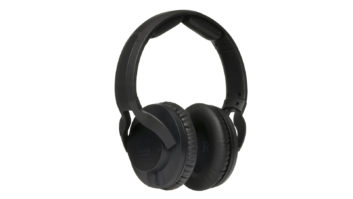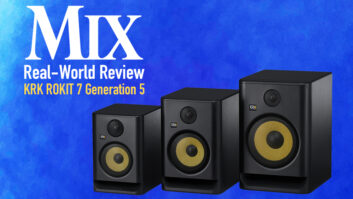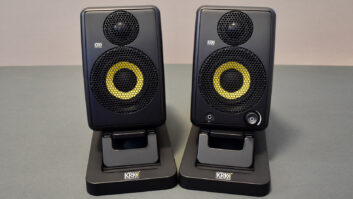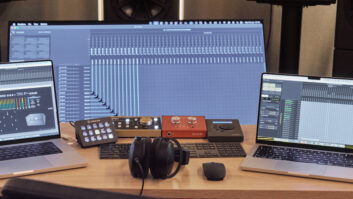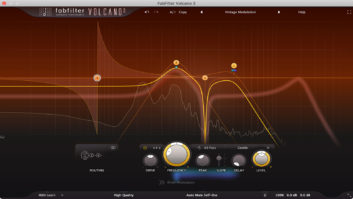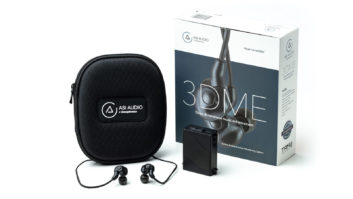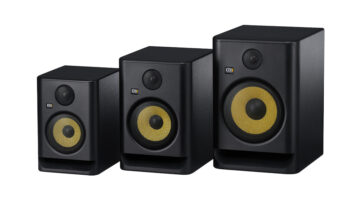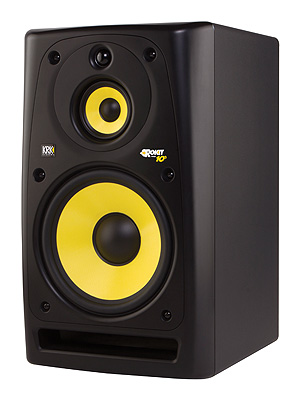
Most engineers would agree that it’s counterproductive and dangerous to mix at high SPLs all of the time. However, there are times during the mix and tracking/overdubbing processes when you want to really crank it up. Sometimes it’s just to do a reality check on your mix—if it’s something that’s going to be played back at high levels—or possibly your clients are asking to hear it loud.
Commercial studios frequently have large-format speakers mounted in their walls for that purpose. For today’s project and home facilities frequently only have near-fields, which, for the most part, aren’t ideally suited for that kind of cranked-up, pulse-pounding playback. But for many studios and musicians, the cost of buying monitors that are capable of putting out high SPLs with full-frequency-range response has been prohibitive—until now.
BLAST OFF
KRK introduced the Rokit RP10-3 at the 2011 Musikmesse, and the product recently started shipping. These monitors, which can be used in mid-field or near-field applications, feature three-way reproduction, with a 10-inch glass Aramid–composite woofer, a 4-inch mid-frequency driver of the same material and a 1-inch silk-dome tweeter. According to the spec sheet, they can put out 113dB max SPL, which is more than your typical near-fields but right in range with competitors in the three-way monitor category. What’s not in range with the rest of that market is the price—$499 per speaker—which is half of its nearest-priced competitor (the ADAM A77X) and a third or less of what many of the other three-way mid-fields cost.

The RP10-3s are large: Each is 29.3×12.8×14.4 inches and weighs a fairly hefty 46 pounds. The cabinet is made of reinforced MDF (Medium-Density Fiberboard) with the distinctive yellow KRK cones on the drivers. The cabinet contains a curved baffle that KRK says virtually eliminates distortion caused by diffraction. A horizontally oriented port at the bottom-front of the cabinet extends to just beyond the width of the low-frequency driver. KRK says the reason for placing the port on the front rather than the rear is to avoid possible bass issues that could occur with a rear-firing port on a speaker that’s mounted on or placed close to a wall.
Along with the grounded IEC AC receptacle, all of the controls and inputs reside on the back of the RP10-3, including the power switch. I have always found front-mounted power switches to be more convenient. That’s a minor point, considering that most studios will power up their speakers from a remote switch. The power indicator is on the front and takes the form of a KRK logo that lights up.
Kudos to KRK for offering three different connection options for the speaker’s audio input: balanced XLR and ¼-inch, or unbalanced RCA. You get a detented volume control that lets you cut up to 30 dB and boost up to 6 dB from unity gain. There are two EQ controls that allow you to tailor the speakers to your room acoustics: an LF adjust and an HF adjust. Both offer four detented positions: -2 dB, -1 dB, 0 dB and +1 dB. According to KRK, each of these controls adjust the “output most commonly affected by room acoustics” within their frequency range.
The RP10-3 is equipped with a tri-amplification system featuring 30W amps for the tweeter and midrange driver, and an 80W amp for the woofer. Crossover frequencies are 350 Hz and 3.5 kHz. According to the specifications, the frequency response of the monitors is 35 to 20k Hz, ±2 dB.
One of the interesting features of the RP10-3 is that if you prefer to orient the speaker horizontally (perhaps in a wall-mounting situation), you can rotate the tweeter 90 degrees so that it’s properly configured. You have to open up the cabinet to do so, but it’s not terribly involved. (See “Try This” sidebar.)

The KRK RP10-3s offer four detented adjustments for LF and HF.
MULTIDIMENSIONAL
I set the monitors up vertically, putting them on Primacoustic Recoil Stabilizers and sitting them on equal-height cabinets to either side of my mix position. I first tried listening to a variety of music on the RP10-3s to see how they’d handle different genres. I found their three-way sound to be clear, crisp and transparent, making it easy to hear musical elements in all frequency ranges.
Having the 10-inch driver really made a difference in the low-end response. As expected, I could hear low frequencies in the bass instruments that were not audible on my smaller monitors. The tightness of the bass was most impressive: Electric bass guitars sounded smooth and contained, not flabby; kick drums were tight-sounding, too. The acoustic bass on a live recording of Oscar Peterson’s “Night Train” felt like it was in the room with me (as did the rest of the instruments). I liked that the KRKs didn’t accentuate the bottom end, just reproduced it—no hype. I was also able to judge pretty clearly when I heard a mix that was overly bassy.
The midrange didn’t jump out like it does on some smaller two-way monitors, but it was certainly present. Thick rock-rhythm guitars, like on The Offspring’s “Nitro,” stayed nice and present, and fit nicely in the track, as they were intended.
The highs seemed a tad on the harsh side to my ears. Bearing in mind that my studio tends to be a little high-end heavy, I lowered the HF adjust to the -1dB setting, which smoothed it out nicely.
I listened first in a near-field configuration and then moved further back to a mid-field distance, and the sound was excellent in both situations. I felt like I could distinguish between the mix elements in a way that I couldn’t on my various smaller monitors. Then to really put them through their paces, I turned them up to close to 100 dB, and they stayed crisp and clean. I put on a track by dub-step artist Bassnectar that has a huge synth bass sound, and I felt the floor vibrating.
I also tried the KRKs in my own mixing situations for some rootsy acoustic music tracks featuring drums, acoustic bass and instruments like dobro, acoustic guitar and mandolin, and I really liked the way the speakers sounded. I found them very useful for judging all aspects of the mix.
ROKIT ‘N’ ROLL
For the money, there’s nothing that I know of on the market like the Rokit RP10-3. If you’ve ever wanted to add a pair of larger-format speakers to your studio, whether to add a three-way mix reference to your studio or just to impress your clients with loud, mid-field playback, the combination of price and performance you get from these monitors is irresistible.
Mike Levine is a New York–based guitarist, composer and music journalist.

Click on the Product Summary box above to view the KRK Rokit RP10-3 Powered Speakers product page.
